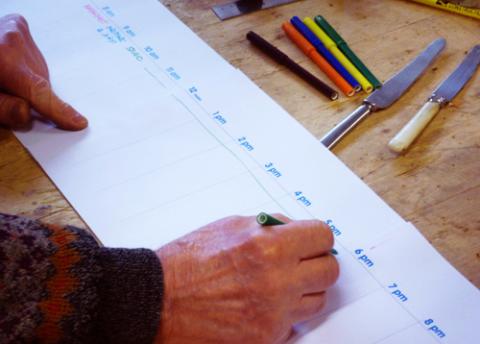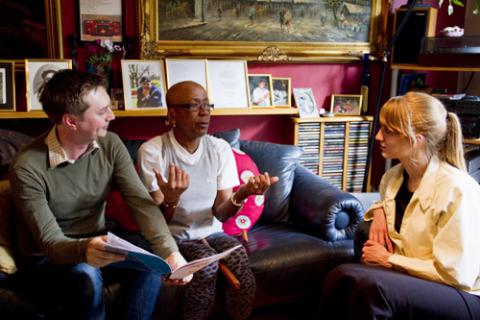This is a guest blog post we were invited to write by Gabrielle Ackroyd, one of the organisers of EPIC 2013, the Ethnographic Praxis in Industry Conference, taking place in London from 15-18 September. Our paper, ‘People and energy: A design-led approach to understanding everyday energy use behaviour’ [PDF] will be presented by Dan on Wednesday 18 September. The post originally appeared on the EPIC 2013 blog.
People, energy and everyday life in London

Editor’s Note: This is the first in a series of blog posts introducing some of the (perhaps lesser known) ethnographic activities taking place in and around London, particularly in line with this year’s theme of widening the EPIC gene pool.
Based at the Royal College of Art, the Helen Hamlyn Centre for Design and SustainRCA are partners in SusLabNWE (2012-15), an interreg-funded European collaboration between research organisations in the Netherlands, Sweden, Germany and UK.
The overall theme of the collaborative projects is the reduction of domestic energy use through encouraging behaviour change, via developing and testing new products, services and interfaces. This encompasses a broad scope of work and expertise, and the team includes environmental scientists and architects, alongside design researchers. The project benefits from ‘Living Lab’ instrumented houses in each country, which will provide a platform (albeit artificial) for demonstrating and trialling the interventions developed.
Understanding energy use in everyday life
Reducing energy use is a major societal challenge–there is a vast array of projects and initiatives, from government, industry and academia as well as more locally driven schemes, all aiming to tackle different aspects of the problem. However, many approaches, including the UK’s smart metering rollout, largely treat ‘energy demand’ as something almost homogeneous, to be addressed primarily through pricing-based feedback, rather than being based on an understanding why people use energy in the first place–what are they actually doing?
We contend that people don’t set out to ‘use energy’: instead, they’re solving everyday problems, meeting needs for comfort, light, food, cleaning and entertainment, sometimes with an emotional dimension. Equally, people’s understandings–mental models–of what energy is, and how their actions relate to its use, are under-explored, and could be extremely important in developing ways of visualising energy use which are meaningful for householders. This is where ethnographic research can provide insights which are directly useful for the design process.

From our point of view at the RCA, Phase 1 of the project (which Dan will be talking in more detail about at EPIC 2013) –is based around a programme of home visits with in-depth interviews and probe/diary studies, paired with quantitative sensing of electricity and gas use and everyday activity (thanks to our partners at the Institute for Sustainability and Imperial College London).
By finding useful ways of integrating the qualitative and quantitative, we are trying to develop a fuller picture of the contexts and nuances of energy use in everyday life–hopefully working towards addressing Tricia Wang’s discussion around ‘thick’ data and ‘big’ data within the energy context, although not Carl Miller’s points about social media. Certainly, energy use is an area where there is a lot of big data around, but less usage which takes account of context and meaning.
A hackday this autumn will bring together our Phase 1 participants with the energy monitoring and ‘maker’ community of designers, developers and researchers, and we will translate the insights from our ethnographic work into co-created prototype interventions (which could be new products, services or interfaces). We’ll initially be trialling the things developed in the network of ‘Living Lab’ houses across north-west Europe in 2014, as well as in participants’ homes themselves in Phase 3. The London lab is being constructed in the London Sustainable Industries Park, Dagenham by the Institute for Sustainability.

Central to the project is the development of people-centred design research methodologies that can provide insights about the usability and adoption of sustainable innovations, across many sectors, to partners with other disciplinary focuses. Flora, with the RCA’s Catherine Greene and Rama Gheerawo, has led on the development of a design research methodology toolkit for SusLabNWE, including observational techniques, self-reporting methods, and product and service prototyping; the kit has been disseminated to all project partners and is informing the design research undertaken in all the regions of the project.
Learning from lead users
Following the Helen Hamlyn Centre’s established research methodologies, developed in the context of inclusive design, in our ethnography we’re focusing on lead users in one form or another – people who have particular needs around, or interest in, energy use at home, and who are indeed often self-described ‘edge cases’.
In our initial group of 10 participants, of a range of ages, backgrounds and family situations, we have:
- Social housing tenants on very limited incomes
- People who are already part of existing programmes aimed at saving energy (via home energy displays and online monitoring) and people who have taken it upon themselves to cut their energy use without using any kind of display
- People with medical needs which mean they use higher than average amounts of gas for heating
- People with strong environmental motivations and people much more focused on cost
- People from the ‘internet of things’ and ‘quantified self’ communities, who have set up their own home energy monitoring systems for their own interest, and have incorporated using the systems into their everyday routines
What we’ve learned so far has already given us much deeper insights into phenomena such as the everyday strategies and routines people have around energy use, how they categorise and separate activities, self-imposed rules around payment schedules, household ‘policies’ on using particular appliances, unexpected use-cases for energy displays, and some intriguing conceptions of ‘what energy looks like’. In our EPIC 2013 paper and presentation, we’ll go into more detail on these insights and the implications they have for the design process.

Photo by Karolina Raczynska
Some of our ‘early adopter’ lead users could be in the vanguard of coming trends around technology use at home, but equally, trends also represented in our group, such as ageing populations and more in-home care provision, will have other effects on energy use. The idea is that through learning from these interested users–understanding their routines, their motivations, their interactions with technology (and in most cases having quantitative data about their actual energy use to integrate with the qualitative insights) we can identify design opportunities for interventions which take account of the real contexts of everyday energy use.
Main EU SusLabNWE project website | SusLab at the RCA website
Dr Dan Lockton (dan.lockton@rca.ac.uk) is a senior associate at the Royal College of Art’s Helen Hamlyn Centre for Design, specialising in links between design and behaviour, and public understanding of everyday systems, particularly with respect to the social and environmental impacts of technology. He was previously a research fellow at WMG, University of Warwick. His PhD at Brunel University, Design with Intent, involved developing a toolkit for the emerging field of ‘design for behaviour change’, and he also consults as Requisite Variety. At EPIC 2013, he’ll be presenting a paper about the SusLabNWE project described in this blog post.
Flora Bowden (flora.bowden@rca.ac.uk) completed her Master of Architecture in Urban Design at the Bartlett School of Architecture in 2009 and is now a research associate for SustainRCA, at the Royal College of Art. She is interested in issues of time and space, place and change, and how we perceive and engage with change over time, and also in analysing uses of space, in mapping and visualising movements and patterns, combining this with a deep understanding of the social and cultural context, to explore how environments shape and are shaped by inhabitants and events.